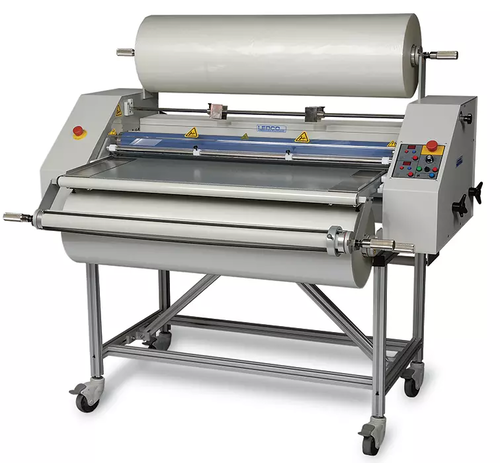Roll Laminating Machines - FAQ
Why
do I need a laminating machine?
Why
shouldn’t I just send my work out to a local laminator? One reason is that most commercial or "trade" laminators have
large equipment and focus on higher-volume jobs. Another reason is that trade laminators are
not generally comfortable laminating digital graphics, and they are often wary of
ruining costly digital graphics. Finally, because most trade laminators are geared toward high volume
conventional printers, they often charge high prices for laminating short-runs. Also, digital graphics generally require
higher quality and more expensive laminating films than conventionally printed
graphics. These more expensive films often
have lower temperature requirements and more aggressive adhesives, making them
suitable for digital prints. Finally,
fast turnaround is important – and by sending out your work you must wait for
it to be done and, very often, you will pay a premium for a rush.
So join the growing numbers of libraries, offices, bakeries, groceries, retail stores, factories, schools, graphic shops, advertising agencies and pick out a laminating machine that is appropriate for your needs. In the long run, you’ll get a great job, you’ll save money, you’ll have the materials laminated when you need them, at a price you can afford!
What
type of materials can I laminate?
Pretty much any paper stock that has a drawing or printing on it may be laminated. If you're just getting into digital graphics, or if you’re long-established in the printing market, the first and most important step in selecting the right laminator and mounter is deciding what your finished products will be. Are you making posters, menu cards, displays, signs, cards, sell-sheets, flip charts, placemats, fan-card sets, portfolios, resumes, recipe cards, or safety signs or graphics? In order to pick the right equipment, you must have an idea what your finished product will be used for, and how many units you’ll be producing over time. Once you have an idea of these factors, give us a call, and let us guide you to an appropriate solution!
What is better for me, hot or cold laminations?
- "Hot" machines use thermal laminating film that has adhesives which are applied with heat and pressure. These adhesives are activated at temperatures ranging from 220°F to 300°F.
- "Cold" machines, which use pressure-sensitive films which are applied only by pressure and without heat.
- Dual-purpose machines that may be run with either heat-activated or pressure-sensitive materials.
Many high-volume commercial or trade laminating businesses laminate everything using hot machines. Many digital graphic shops utilize pressure-sensitive or cold laminations only, because many digital prints are extremely sensitive to heat and will change color or even melt with the heat of some laminating machines. Further, while pressure-sensitive laminating films are more expensive than thermal films, they are also more aggressive bonding, especially with digital prints, so certain types of printing require the more expensive pressure-sensitive laminating materials.
If you have a question about what machine is right for you, please ask one of our technical customer service reps who are standing by to take your calls today!
What type of mounting can I do?
Some
laminating machines are designed as mounting machines also. Most mounting
machines use cold pressure-sensitive adhesives to adhere printed paper to a
variety of substrates. These substrates
may include foam-board, gator-board, sintra, aluminum, Dibond, Plexiglas and
more. The opening between the “nip”
rollers will determine how thick a substrate may be used. Many machines will allow up to 1” or more
thickness!
Some
laminating and mounting dual machines will allow you to imaging simultaneously
mount and laminate items in one pass through the machine, although most
machines operate these functions independently. For those, the images are run
through the machine twice, first to laminate, then to mount.
What should my laminator be able to do?
Following
are some of the specific functions you should consider before choosing a
laminator. Which of these functions you require will depend on the type of
materials you are laminating and how you plan to use the finished product.
Encapsulation: laminating 2 sides of the paper at one time so there is a border of clear plastic all around the paper, completely sealing the paper in plastic.
Laminating thickness: Some laminating machines can only laminate thin films, others are more adaptable to a variety of laminating film thicknesses. The thickness of the film will make it more or less flexible and more or less durable.Mounting: adhering your printed paper to a thick substrate such as cardboard, sintra, foam board, gator board, aluminum, or wood.
Thermal (“Hot”) lamination: laminating paper using heat-activated laminating film. This type of film is generally less costly than pressure sensitive films but may not be appropriate for certain types of digital prints.Pressure-Sensitive (“Cold”) lamination: laminating paper and other substrates using cold, pressure-sensitive laminating film. Most high-end digital graphic shops use this type of lamination for short-run display work, especially wide format posters and banners. These laminating machines often come with a release liner take-up roll, which saves production time.
Automatic slitters: these are special knives that are built in to the laminating machine and allow you to trim the laminating film right to the finished size as you go, without hand-trimming after lamination.One-Side or Two-Sided Laminators: be sure you are choosing a laminator that enables you to run two sides in one pass if you want to encapsulate your printed materials in plastic. For other purposes, a one-sided laminating machine may be used to laminate one side as well as two sides, by running the paper through the machine in a second pass.
